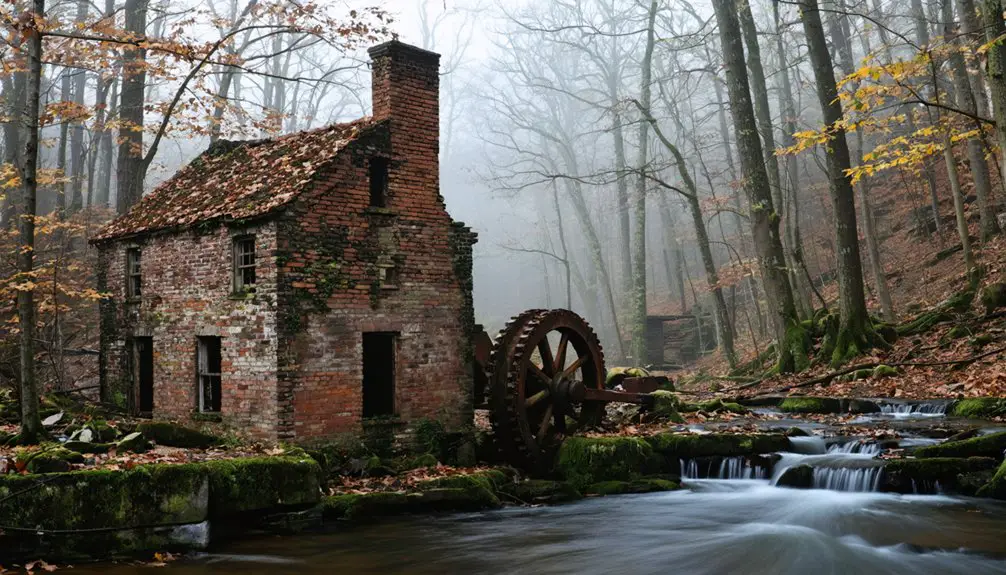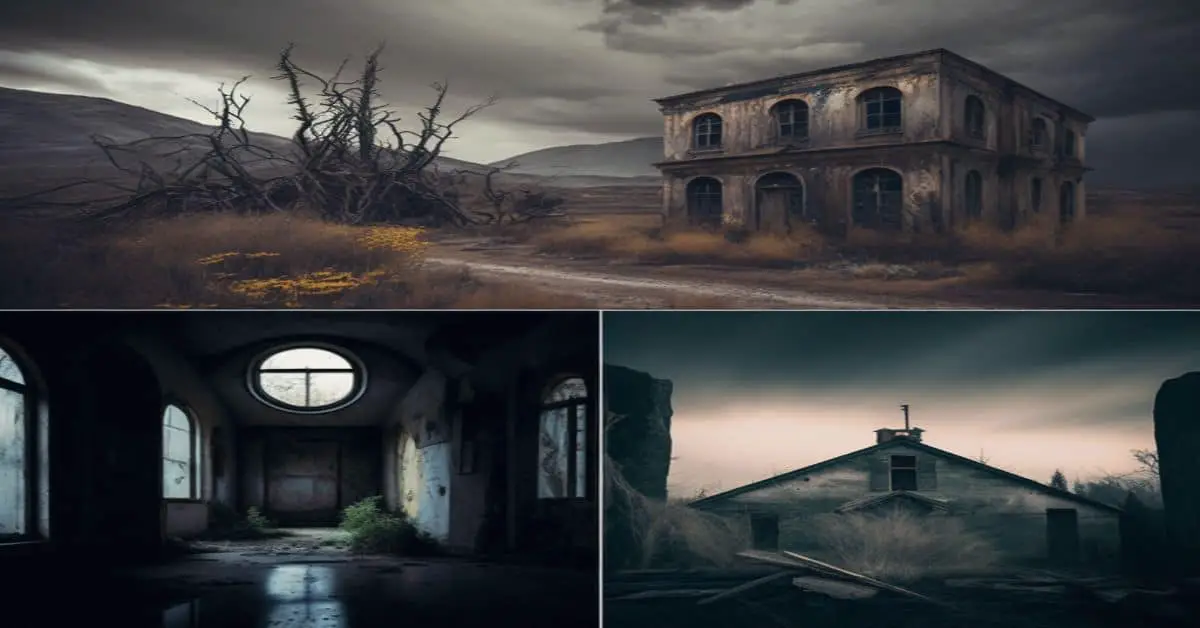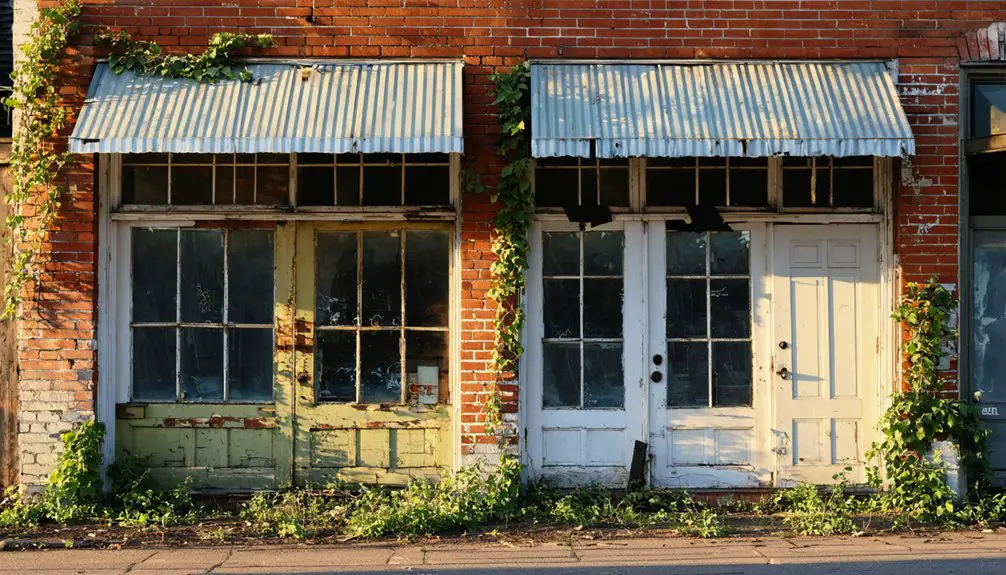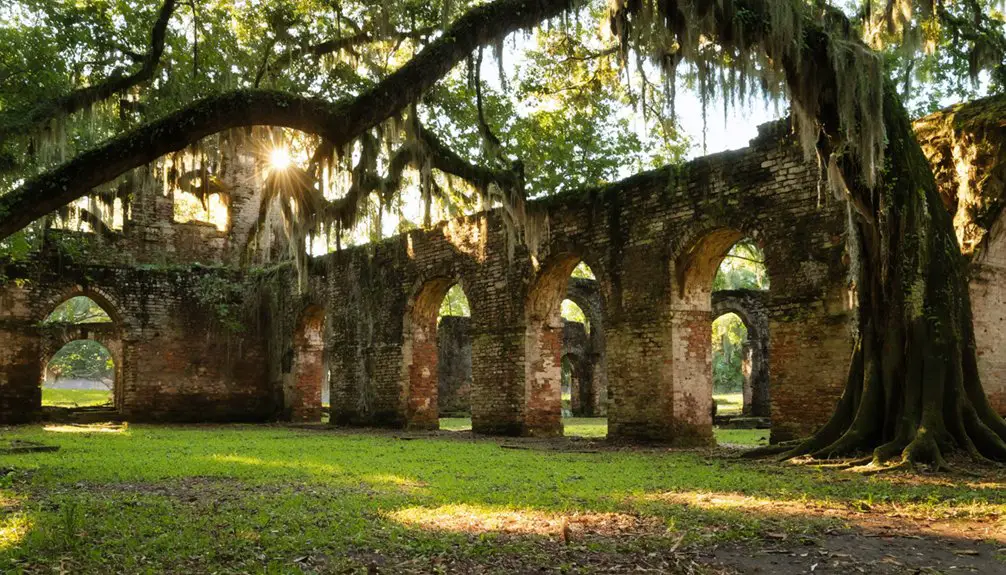You’ll find Mortimer nestled in western North Carolina’s Pisgah National Forest, where a once-bustling lumber town of 800 residents thrived in the early 1900s. The Ritter Lumber Company established this mountain community in 1904, complete with sawmills, stores, and a hotel. Nature had other plans, though – devastating floods and fires in 1916 and 1940 led to its abandonment. Today, hiking trails wind through the ghost town’s haunting remains, each crumbling foundation telling its own story.
Key Takeaways
- Mortimer was a thriving mill town established in 1904 by Ritter Lumber Company, reaching a peak population of 800 residents.
- The town featured a sawmill, textile mill, company store, and Laurel Inn, supported by narrow gauge railroad tracks along Wilson Creek.
- Devastating floods in 1916 and 1940, along with fires, destroyed vital infrastructure and led to the town’s eventual abandonment.
- After Ritter Lumber Company’s withdrawal and repeated natural disasters, Mortimer transformed into a ghost town within Pisgah National Forest.
- Today, visitors can explore building foundations and old machinery through marked hiking trails in Pisgah National Forest’s Mortimer Campground area.
The Birth of a Lumber Empire
In 1904, Ritter Lumber Company‘s strategic purchase of land around Mortimer, North Carolina marked the beginning of a transformative logging enterprise in the western part of the state.
You’ll find that this industrial giant quickly established a bustling mill town, positioning itself at the heart of the region’s lumber history between Wilson and Steel Creeks.
The company’s industrial impact was staggering – contributing to western North Carolina’s annual lumber shipments valued at four million dollars.
You can imagine the rapid transformation as Ritter constructed essential infrastructure: a sawmill, textile mill, company store, and the Laurel Inn.
They didn’t stop there; they laid narrow gauge railroad tracks along Wilson Creek to Edgemont, creating an efficient timber transportation network that would shape the region’s economic landscape for years to come.
The town thrived with a population of 800 during its peak years in the early 1900s.
Sadly, a series of devastating fires and floods beginning in 1916 would eventually lead to the town’s decline.
Peak Years and Industrial Growth
By the late 1920s, you’d find Mortimer at its bustling peak with up to 800 residents living and working in this mountain mill town.
Like the powerful Norman barons who ruled medieval England, the industrialists brought prosperity and growth to the region.
You could see the town’s industrial evolution from its lumber roots as the United Mills Company established a cotton mill operation in 1922, bringing new life to the community.
The mill operations expanded further when O.P. Lutz purchased Mortimer and invested in sophisticated German hosiery manufacturing equipment, though this venture would prove short-lived due to the devastating 1940 flood.
The town originally served as housing for workers employed by the Ritter Lumber Company in the early years of the twentieth century.
Mill Operations Expand
When Ritter Lumber Company purchased land near Mortimer in 1904, the town’s industrial landscape transformed rapidly into a bustling mill operation. The company’s strategic development included a sawmill, textile mill, and narrow gauge railroad along Wilson Creek, maximizing lumber production efficiency.
You’ll find that by 1912, the region’s timber industry was booming, with western North Carolina shipping an estimated four million dollars’ worth of lumber.
As industrial expansion took hold, Ritter Lumber Company built essential infrastructure to support their growing workforce. The town reached its peak with over 600 residents by 1929. Company workers frequented a local store that served as both a supply hub and social gathering spot.
You’d have seen a company store, blacksmith’s shop, church, school, and hotel spring up around the mill operations. These amenities created a self-sufficient community centered around the thriving lumber industry, marking Mortimer’s peak as a mill town.
Population Reaches 800 Residents
Mortimer’s population surged to 800 residents during its industrial prime, transforming the once-quiet mountain settlement into a vibrant mill town.
You’d have found a bustling community supported by the Ritter Lumber Company, where workers and their families created a dynamic social fabric. Cotton mill initiatives emerged during the Great Depression as the town sought to diversify its economy. Like Portsmouth’s historic peak of 685 residents in 1860, Mortimer experienced its own demographic surge that shaped the region. As demographic changes swept through the area, the town developed essential community amenities including hotels, a cinema, and retail establishments to serve its growing population.
The Lauren Inn became a cornerstone of local hospitality, even hosting Theodore Roosevelt during its heyday.
You would’ve witnessed a thriving mountain community where mill workers, merchants, and service providers contributed to a diverse local economy. The town’s prosperity relied heavily on its industrial base, though this dependence would later prove catastrophic when natural disasters struck.
Natural Disasters Strike
If you’d visited Mortimer in 1916, you’d have witnessed a devastating wildfire that swept down from Grandfather Mountain through Wilson Creek, destroying forests and buildings before a catastrophic flood washed away the logging railroad and Lake Rhodhiss Dam.
Today, visitors can explore remnants of mill machinery and building foundations that hint at the town’s industrial past.
The town’s struggles continued when a 1940 coastal hurricane triggered unprecedented flooding, with Wilson Creek reaching a staggering 94-foot flood stage that submerged the entire community.
These natural disasters, combined with the loss of the Ritter Lumber Company and railway infrastructure, transformed this once-thriving mill town into an abandoned settlement within the span of just 24 years.
Fire Decimates Lumber Industry
Devastating fires in 1916 marked the beginning of the end for Mortimer’s once-thriving lumber industry. Starting on Grandfather Mountain’s slopes, intense winds drove flames through Wilson Creek valley, destroying critical infrastructure including sawmills, railroad bridges, and logging railways.
The fire consequences were immediately compounded by devastating floods, crippling Ritter Lumber Company’s operations. Similar to operations at Halifax Paper Co., the lumber processing facilities were crucial to the local economy.
The economic decline was swift and severe. Within a year, Ritter Lumber withdrew completely, leaving behind stripped mountainsides and widespread unemployment.
While the Civilian Conservation Corps attempted repairs in the 1930s, and a hosiery mill briefly operated, Mortimer never recovered its industrial vigor.
The destruction discouraged new investment, and repeated natural disasters through the 1940s sealed the town’s fate, transforming it into the ghost town you can visit today.
Devastating Floods Destroy Infrastructure
Following the catastrophic fires, a series of devastating floods struck Mortimer between 1916-1940, delivering the final blow to the town’s infrastructure.
The first major flood impacts in 1916 severely damaged the narrow gauge railroad, disrupting essential transportation networks used for logging operations.
But it was the catastrophic 1940 flood that sealed Mortimer’s fate. You can still see evidence of the infrastructure collapse today – railroad ties and track sections scattered along Wilson Creek, and crumbling foundations where buildings once stood.
The floodwaters destroyed bridges, mills, and roadways, effectively isolating the town. With its economic lifeline severed, Mortimer’s population of 800 dispersed, and the once-thriving lumber town transformed into a ghost town, eventually becoming part of Pisgah National Forest.
Nature Claims the Town
Beyond the catastrophic floods, Mortimer faced relentless challenges from nature that accelerated its transformation into a ghost town. The town’s position in the Blue Ridge Mountains left it vulnerable to devastating landslides and slope failures, while harsh storms and bitter winters tested residents’ resilience.
You’ll find evidence of nature’s reclamation throughout the former settlement, where dense forests have steadily consumed abandoned structures and mill remnants. The process of urban abandonment intensified as wildlife returned to reclaim their habitat – bears and deer now roam freely where townspeople once walked.
While wildfires periodically threatened the community’s wooden buildings, it’s the quiet advance of vegetation that’s ultimately obscured much of Mortimer’s physical remains, turning this once-bustling mill town into a wilderness preserve.
Life in Early Mortimer
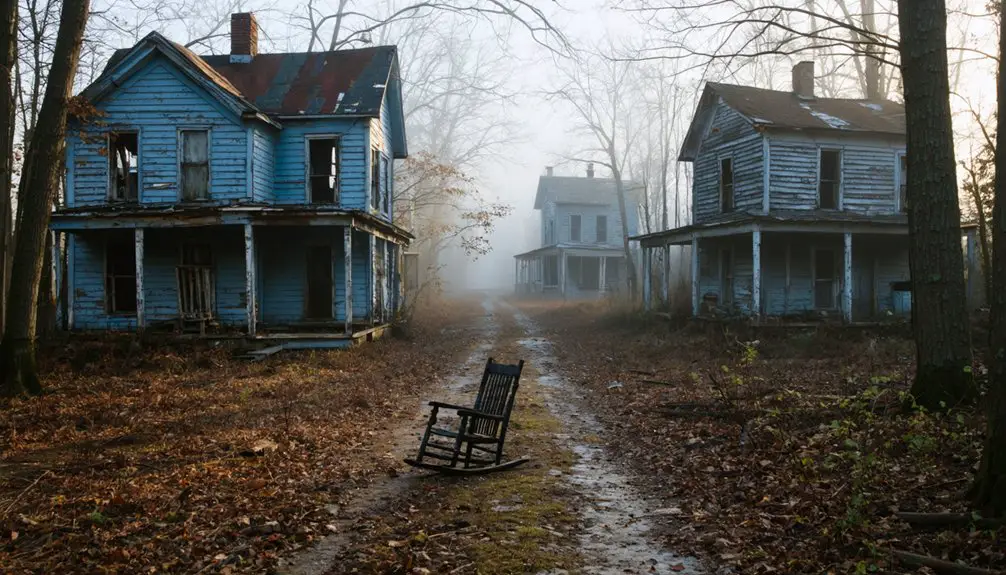
As Ritter Lumber Company established Mortimer in 1904, the once-sparse settlement known as Hauck transformed into a bustling mountain village.
You’d have found a remarkably self-sufficient community, complete with modern conveniences unusual for such a remote location. The company built everything needed for daily life: a store, blacksmith shop, church, school, and hotel.
Community dynamics centered around the lumber operations, with workers and their families creating a tight-knit society despite their diverse origins.
The rhythm of daily routines followed the bi-daily mail deliveries and the constant hum of timber work. While most residents were transient laborers drawn by steady wages, they took pride in their mountain home, enjoying amenities that rivaled larger towns of the era.
Legacy in Ruins
The catastrophic combination of fire and floods between 1916 and 1940 systematically erased Mortimer’s physical presence from Wilson Creek’s landscape.
Today, you’ll find only scattered remnants of this once-thriving mill town: building foundations, old machinery from Ritter Lumber Company, and fragments of the United Mills cotton operation that briefly revived the area in 1922.
While nature reclaims the land within Pisgah National Forest, the ruins preservation efforts are minimal, limited to public land management.
You can explore these historical ruins via hiking trails and the Mortimer Campground, where historical narratives of the town’s industrial era persist.
Around 16 families still call the Wilson Creek area home, living among the echoes of a community that exemplifies the broader story of Appalachian mill town boom and bust.
Modern-Day Adventure and Exploration

Modern adventurers visiting Mortimer’s ruins will find a fascinating blend of historical exploration and outdoor recreation within Pisgah National Forest.
You’ll discover well-marked hiking trails that guide you through the ghost town‘s remains while offering scenic views of Wilson Creek and nearby waterfalls.
You can explore concrete foundations, rusted mill machinery, and other industrial artifacts that tell the story of this once-thriving lumber town.
The Mortimer Campground serves as an ideal base camp, featuring modern amenities like hot showers for extended exploration.
While photographing the historic depot and hotel ruins, you’ll need to watch for unstable structures and seasonal flooding, especially during wet weather.
The site’s mix of natural regrowth and industrial decay creates perfect opportunities for both history enthusiasts and outdoor adventurers.
Frequently Asked Questions
Are There Any Reported Ghost Sightings or Paranormal Activity in Mortimer?
You won’t find documented ghost stories or verified paranormal investigations here. Despite its eerie abandoned buildings and tragic flood history, there’s no official record of supernatural activity in this location.
What Happened to the Residents Who Left After the 1940 Flood?
Like scattered leaves in autumn wind, you’d find these displaced residents relocated throughout Caldwell County and broader North Carolina, seeking new jobs and flood-safe homes after losing everything in 1940.
Is Overnight Camping Allowed Near the Old Town Ruins?
You’ll need to stay at the designated Mortimer Campground sites for overnight camping. There’s no dispersed camping or special overnight permits allowed near the ruins due to preservation regulations.
Can Visitors Collect Artifacts or Relics From the Abandoned Town Site?
As tempting as buried treasure, you can’t collect artifacts from this protected site. Strict relic regulations and artifact preservation laws make removing items illegal, with hefty fines for violators.
Are There Guided Historical Tours Available of the Mortimer Ghost Town?
You won’t find official guided tours, but you’re free to explore the historical significance on your own through the Pisgah National Forest trails or join locals who occasionally share informal stories.
References
- https://albiongould.com/ghost-towns-to-visit-in-the-states/
- https://en.wikipedia.org/wiki/Mortimer
- https://www.treasurenet.com/threads/mortimer-nc.68030/
- https://www.atlasobscura.com/places/mortimer-north-carolina
- https://www.youtube.com/watch?v=DH5y2iNm2Tg
- https://coastalanglermag.com/wilson-creek-nc-trout-fishing-history/
- https://historictoxaway.org/logging-1900-1920/
- http://www.mtnlaurel.com/backroads/379-mortimer-and-edgemont-north-carolina-backroads-tour.html
- https://www.telegraph.co.uk/women/life/welcome-american-ghost-town-population-six/
- https://goingnowherefastrv.com/appalachian-history-and-mortimer-campground/
